International Journal of Information Technology and Computer Science @ijitcs
Статьи журнала - International Journal of Information Technology and Computer Science
Все статьи: 1254
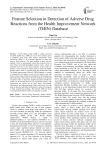
Статья научная
Adverse drug reaction (ADR) is widely concerned for public health issue. ADRs are one of most common causes to withdraw some drugs from market. Prescription event monitoring (PEM) is an important approach to detect the adverse drug reactions. The main problem to deal with this method is how to automatically extract the medical events or side effects from high-throughput medical events, which are collected from day to day clinical practice. In this study we propose a novel concept of feature matrix to detect the ADRs. Feature matrix, which is extracted from big medical data from The Health Improvement Network (THIN) database, is created to characterize the medical events for the patients who take drugs. Feature matrix builds the foundation for the irregular and big medical data. Then feature selection methods are performed on feature matrix to detect the significant features. Finally the ADRs can be located based on the significant features. The experiments are carried out on three drugs: Atorvastatin, Alendronate, and Metoclopramide. Major side effects for each drug are detected and better performance is achieved compared to other computerized methods. The detected ADRs are based on computerized methods, further investigation is needed.
Бесплатно
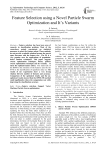
Feature Selection using a Novel Particle Swarm Optimization and It’s Variants
Статья научная
Feature selection has been keen area of research in classification problem. Most of the researchers mainly concentrate on statistical measures to select the feature subset. These methods do not provide a suitable solution because the search space increases with the feature size. The FS is a very popular area for applications of population-based random techniques. This paper suggests swarm optimization technique, binary particle swarm optimization technique and its variants, to select the optimal feature subset. The main task of the BPSO is the selection of the features used by the SVM in the classification of spambase data set. The results of our experiments show a very strong relation between number of features and accuracy. Comparison of the optimized results and the un-optimized results showed that the BPSO-MS method could significantly reduce the computation cost while improving the classification accuracy.
Бесплатно
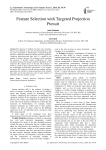
Feature Selection with Targeted Projection Pursuit
Статья научная
The selection of attributes becomes more important, but also more difficult, as the size and dimensionality of data sets grows, particularly in bioinformatics. Targeted Projection Pursuit is a dimension reduction technique previously applied to visualising high-dimensional data; here it is applied to the problem of feature selection. The technique avoids searching the powerset of possible feature combinations by using perceptron learning and attraction-repulsion algorithms to find projections that separate classes in the data. The technique is tested on a range of gene expression data sets. It is found that the classification generalisation performance of the features selected by TPP compares well with standard wrapper and filter approaches, the selection of features generalises more robustly than either, and its time efficiency scales to larger numbers of attributes better than standard searches.
Бесплатно
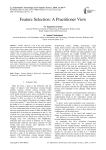
Feature Selection: A Practitioner View
Статья научная
Feature selection is one of the most important preprocessing steps in data mining and knowledge Engineering. In this short review paper, apart from a brief taxonomy of current feature selection methods, we review feature selection methods that are being used in practice. Subsequently we produce a near comprehensive list of problems that have been solved using feature selection across technical and commercial domain. This can serve as a valuable tool to practitioners across industry and academia. We also present empirical results of filter based methods on various datasets. The empirical study covers task of classification, regression, text classification and clustering respectively. We also compare filter based ranking methods using rank correlation.
Бесплатно
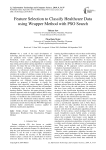
Feature selection to classify healthcare data using wrapper method with pso search
Статья научная
As a result of the rapid development of technology, data that contain a large number of features are produced from various applications such as biomedical, social media, face recognition, etc. Processing of these data is a challenging task to existing data mining and machine learning algorithms to make the decision. To reduce the size of the data for processing, a feature selection technique is needed. The feature selection is a well-known attribute selection or variable selection. The objective of the feature selection is to minimize the number of attributes contains in the dataset by eliminating the unwanted and repeated attributes to improve the classification accuracy and reduce the computation cost. Although various feature selection methods are proposed, in literature, to classify the healthcare data especially cancer diagnosis, finding an informative feature for medical datasets has still remained a challenging issue in the data mining and machine learning domain. Therefore, this paper presents a feature selection approach with the wrapper method (WFS) using particle swarm optimization (PSO) search to improve the accuracy of healthcare data classification. This work is evaluated on five benchmark medical datasets publicly available from the UCI machine learning repository. The experimental results showed that the WFS-PSO approach produces higher classification accuracy applied to different classification algorithms.
Бесплатно
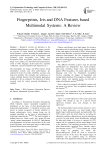
Fingerprints, Iris and DNA Features based Multimodal Systems: A Review
Статья научная
Biometric systems are alternates to the traditional identification systems. This paper provides an overview of single feature and multiple features based biometric systems, including the performance of physiological characteristics (such as fingerprint, hand geometry, head recognition, iris, retina, face recognition, DNA recognition, palm prints, heartbeat, finger veins, palates etc) and behavioral characteristics (such as body language, facial expression, signature verification, speech recognition, Gait Signature etc.). The fingerprints, iris image, and DNA features based multimodal systems and their performances are analyzed in terms of security, reliability, accuracy, and long-term stability. The strengths and weaknesses of various multiple features based biometric approaches published so far are analyzed. The directions of future research work for robust personal identification is outlined.
Бесплатно
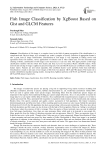
Fish Image Classification by XgBoost Based on Gist and GLCM Features
Статья научная
Classification of fish image is a complex issue in the field of pattern recognition. Fish classification is a complicated task. Physical shape, size, orientation etc. made it complex to classify. Selection of appropriate feature is also a great issue in image classification. Classification of fish image is very important in fishing service and agricultural field, fish industry, survey applications of fisheries and in other related area. For the assessment and counting of fishes, classification of fish image is also necessary as it can save time. This paper presents a fish image classification method with the robust Gist feature and Gray Level Co-occurrence Matrix (GLCM) feature. Noise removal and resizing of image is applied as pre-processing task. Gist and GLCM feature are combined to make a better feature matrix. Features are also tested separately. But combined feature vector performs better than individual. Classification is made on ten types of raw images of fish from two datasets -QUT and F4K dataset. The feature set is trained with different machine learning models. Among them, XgBoost performs with 90.2% and 98.08% accuracy for QUT and F4K dataset respectively.
Бесплатно
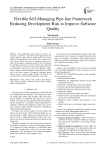
Flexible Self-Managing Pipe-line Framework Reducing Development Risk to Improve Software Quality
Статья научная
Risk identification and assessment in today’s sce-nario play a vital role in any software/web application devel-opment industry. Many process models deliver the process related to development life cycle, but the risk assessment at an early stage is still an issue and is a significant subject for research. In this paper, an approach based on MVC architecture by embedding spiral process, which is verified and validated by V-shape model is proposed. By using this approach development efficiency will increase due to less burdened working team(s), reduces stressful maintenance effort that causes reduction in risk factors because of beautifully distributed human effort to improve software quality. Besides, the efficiency of our approach is manifested by the preliminary experiment.
Бесплатно
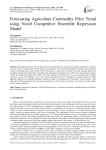
Forecasting Agriculture Commodity Price Trend using Novel Competitive Ensemble Regression Model
Статья научная
This paper introduces a novel approach for forecasting the price trends of agricultural commodities to address the issue of price volatility faced by both farmers and consumers. The accurate forecasting of food prices is particularly crucial in emerging nations such as India where food security is a top priority. To achieve this goal, the paper presents an ensemble learning-based approach for predicting the agricultural commodity price (ACP) trend. Using dataset namely rainfall and wholesale pricing index (WPI), the study compares the performance of various individual and ensemble regression models. The findings of this work demonstrated that the novel competitive ensemble regression (CER) approach outperforms traditional individual regression models in predicting price fluctuations trend accurately. This approach has the high potential and more precise prediction to afford farmers and dealers, also make the model suitable for the financial industries.
Бесплатно
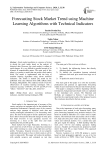
Forecasting Stock Market Trend using Machine Learning Algorithms with Technical Indicators
Статья научная
Stock market prediction is a process of trying to decide the stock trends based on the analysis of historical data. However, the stock market is subject to rapid changes. It is very difficult to predict because of its dynamic & unpredictable nature. The main goal of this paper is to present a model that can predict stock market trend. The model is implemented with the help of machine learning algorithms using eleven technical indicators. The model is trained and tested by the published stock data obtained from DSE (Dhaka Stock Exchange, Bangladesh). The empirical result reveals the effectiveness of machine learning techniques with a maximum accuracy of 86.67%, 64.13% and 69.21% for “today”, “tomorrow” and “day_after_tomorrow”.
Бесплатно
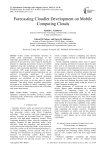
Forecasting cloudlet development on mobile computing clouds
Статья научная
Article studies development dynamics of mobile cloud technologies. Advantages of this technology and problems occurring during its use are analyzed. At the same time, issues related to meeting the demand of computing and memory resources of mobile equipment using this technology are studied. For this purpose, main monitoring parameters, especially delays in network, CPU usage percentage, memory usage, completion time of intended essential operations etc. are analyzed. Considering significance of selected parameters in Cloudlet creation, Integral monitoring parameter was established. In the article analyze technologies were given as the time series of integral parameter. Thus article studies conditions necessitating development of cloudlets on mobile computing clouds and solves issues of forecasting location time of cloudlets near certain base stations.
Бесплатно
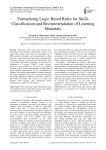
Formalizing logic based rules for skills classification and recommendation of learning materials
Статья научная
First-order logic based data structure have knowledge representations in Prolog-like syntax. In an agent based system where beliefs or knowledge are in FOL ground fact notation, such representation can form the basis of agent beliefs and inter-agent communication. This paper presents a formal model of classification rules in first-order logic syntax. In the paper, we show how the conjunction of boolean [Passed, Failed] decision predicates are modelled as Passed(N) or Failed(N) formulas as well as their implementation as knowledge in agent oriented programming for the classification of students’ skills and recommendation of learning materials. The paper emphasizes logic based contextual reasoning for accurate diagnosis of students’ skills after a number of prior skills assessment. The essence is to ensure that students attain requisite skill competences before progressing to a higher level of learning.
Бесплатно
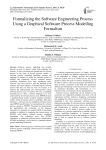
Formalizing the Software Engineering Process Using a Graphical Software Process Modelling Formalism
Статья научная
Software process modelling has recently become an area of interest within both academia and industry. It aims at defining and formalizing the software process in the form of formal rigorous models. A software process modelling formalism presents the language or notation in which the software process is defined and formalized. Several software process modelling formalisms have been introduced lately, however, they have failed to gain the attention of the industry. One major objective of formalizing the software process that has ever been an issue of research, is to enhance the understanding and communication among software process users. To achieve this aim, a modelling formalism has to offer a common language to be well-understood by all software process users. BPMN presents a graphical-based widely accepted standard formalism, mainly aimed at business process modelling. This paper illustrates a software process modelling formalism based upon BPMN specifications for representing the software process, named as, SP2MN. The paper also demonstrates the applicability and evaluation of the proposed formalism by; utilizing the standard ISPW-6 benchmark problem, in addition to comparing the expressiveness of SP2MN with similar software process modelling formalisms. The evaluations prove that SP2MN contributes in enhancing software process formalization. SP2MN, accordingly, can be used as a standard software process modelling formalism.
Бесплатно
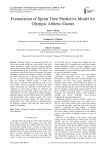
Formulation of sprint time predictive model for olympic athletic games
Статья научная
Olympic Games are international field and track events hosted within four years periods. Like other events, sprinting is a track event that requires rigorous and focused training. When training is done with little or no understanding of the possibilities of the games, the competition would leave more to be desired. This paper formulates, evaluates and validates a model for predicting the fastest sprinting time of Olympic athletes of 100m race for a-5 season appearances. Dataset was obtained from the Olympic official records of world best performances, typically Gold medalists in sprint for the male category from the inception in 1896 to the 2016 edition. The model was simulated on MATLAB. Cross-validation was done using residuals for whiteness and independence tests and model outputs. The results were evaluated based on Sum of Square Error (SSE), R-Square, adjusted R-Square, and Root Mean Square Error (RMSE) and benchmarked with existing models. The model outperformed the existing models with higher accuracy and goodness of fit. This prediction is a reasonable guide for predictive training, forecasting and future study on predictive algorithms.
Бесплатно
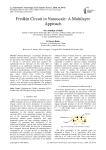
Fredkin circuit in nanoscale: a multilayer approach
Статья научная
Nanotechnologies, exceedingly Quantum-dot Cellular Automata (QCA), presents a notable perception for upcoming nanocomputing. Feature extent of circuits is moving to sub-micron point that produces the sophisticated device intricacies. In this work, QCA is considered as an application technique for reversible logic. A multi-layer reversible Fredkin circuit is proposed with QCA nanotechnology. The accomplishment of the outlined circuit is substantiated with five existing Fredkin gate, which exhibits from 71.20% to 37.50% improvement in term of cell intricacy. The proposed design uses 55 cells concerning only 0.03 μm2 area and latency is 0.75. The power consumption by the proposed circuit is also presented in this literature. The proposed design has been realized with QCADesigner version 2.0.3.
Бесплатно
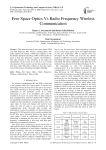
Free Space Optics Vs Radio Frequency Wireless Communication
Статья научная
This paper presents the free space optics (FSO) and radio frequency (RF) wireless communication. The paper explains the feature of FSO and compares it with the already deployed technology of RF communication in terms of data rate, efficiency, capacity and limitations. The data security is also discussed in the paper for identification of the system to be able to use in normal circumstances. These systems are also discussed in a way that they could efficiently combine to form the single system with greater throughput and higher reliability.
Бесплатно
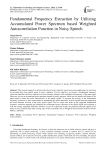
Статья научная
This research suggests an efficient idea that is better suited for speech processing applications for retrieving the accurate pitch from speech signal in noisy conditions. For this objective, we present a fundamental frequency extraction algorithm and that is tolerant to the non-stationary changes of the amplitude and frequency of the input signal. Moreover, we use an accumulated power spectrum instead of power spectrum, which uses the shorter sub-frames of the input signal to reduce the noise characteristics of the speech signals. To increase the accuracy of the fundamental frequency extraction we have concentrated on maintaining the speech harmonics in their original state and suppressing the noise elements involved in the noisy speech signal. The two stages that make up the suggested fundamental frequency extraction approach are producing the accumulated power spectrum of the speech signal and weighting it with the average magnitude difference function. As per the experiment results, the proposed technique appears to be better in noisy situations than other existing state-of-the-art methods such as Weighted Autocorrelation Function (WAF), PEFAC, and BaNa.
Бесплатно
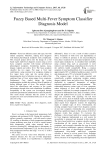
Fuzzy Based Multi-Fever Symptom Classifier Diagnosis Model
Статья научная
Fever has different causes and types, but with similar symptoms. Therefore, making fever diagnosis with human physiological symptoms more complicated. This research project delves into the design of a web based expert multi-fever diagnosis system using a novel fuzzy symptom classifier with human self-observed physiological symptoms. Considering malaria, Lassa, dengue, typhoid and yellow fever. The fuzzy-symptom classifier has two stages. Fist stage is fever type confirmation using common fever symptoms, leading to five major fuzzy rules and the second phase is determining the level of infection (severe or mild) of the confirmed type of fever using unique fever symptoms. Furthermore, Case studies during the system implementation yielded data collected from 50 patients of having different types of fever. The analysis clearly shows the effectiveness and accuracy in the system performance through false result elimination. In addition, acceptability of the system was investigated through structured questionnaire administered to same 50 patients. This result clearly indicates that the system is well accepted, by users and considered fairly easy to use, time and cost saving.
Бесплатно
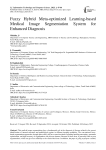
Fuzzy Hybrid Meta-optimized Learning-based Medical Image Segmentation System for Enhanced Diagnosis
Статья научная
This medical image segmentation plays a fundamental role in the diagnosis of diseases related to the correct identification of internal structures and pathological regions in different imaging modalities. The conventional fuzzy-based segmentation approaches, though quite useful, still have some drawbacks regarding handling uncertainty, parameter optimization, and high accuracy of segmentation with diverse datasets. Because of these facts, it generally leads to poor segmentations, which can give less reliability to the clinical decisions. In addition, the paper is going to propose a model, FTra-UNet, with advanced segmentation of medical images by incorporating fuzzy logic and transformer-based deep learning. The model would take complete leverage of the strengths of FIS concerning the handling of uncertainties in segmentation. Besides, it integrates SSHOp optimization technique to fine-tune the weights learned by the model to ensure improvement in adaptability and precision. These integrated techniques ensure faster convergence rates and higher accuracy of segmentation compared to state-of-the-art traditional methods. The proposed FTra-UNet is tested on BRATS, CT lung, and dermoscopy image datasets and ensures exceptional results in segmentation accuracy, precision, and robustness. Experimental results confirm that FTra-UNet yields consistent, reliable segmentation outcomes from a practical clinical application perspective. The architecture and implementation of the model, with the uncertainty handled by FIS and the learning parameters optimization handled by the SSHOp method, increase the power of this model in segmenting medical images.
Бесплатно
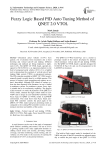
Fuzzy Logic Based PID Auto Tuning Method of QNET 2.0 VTOL
Статья научная
Unmanned aerial vehicles (UAVs) have gained a lot of attention from researchers due to their hovering and vertical take-off and landing. Different techniques and methods are being employed to imple-ment UAVs. The QNET 2.0 VTOL board, specially de-signed for NI ELVIS II, is an important platform in the field of unmanned aerial vehicles (UAV). It is a helpful tool to demonstrate the essentials of vertical take-off and landing flight control (VTOL) at educational institutes. The PID controller installed in QNET 2.0 VTOL board is manually tuned is usually done by a skilled operator. This process of tuning is time-consuming and requires an expert’s knowledge. Although PID control of various sys-tems has been reported in the literature, its use is limited in nonlinear systems. For nonlinear systems. Fuzzy logic is suitable due to its nonlinearity capability. The purpose of this research is to study the dynamics of the QNET 2.0 VTOL model, simulate the flight control model in Lab-VIEW and to design an auto-tuned PID controller using Fuzzy logic for QNET 2.0 VTOL model in LabVIEW environment. This study shows that Fuzzy based auto-tuned PID controller controls the pitch angle of the QNET 2.0 VTOL model and gives promising results as compared to the existing PID controller in terms of auto-tuning in real-time and stability of the system.
Бесплатно

